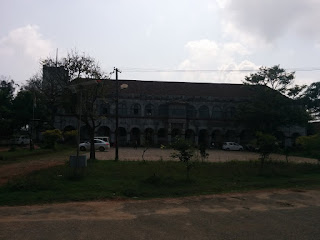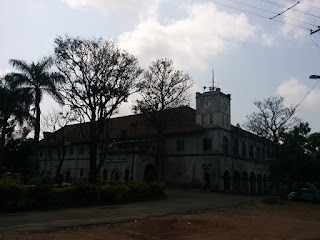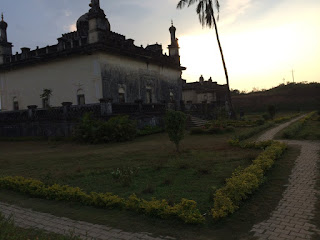This was published on Tuesday, January 10th, 2017 in the Spectrum, Deccan Herald.
Original Draft:
 |
| Fort walls of Madikeri |
Between the years 1583 and 1834, the
Haleri Rajas ruled the erstwhile principality of Kodagu. They built
the town of Madikeri and made it their capital. The chief monuments
that they built in Madikeri are the palace, the Raja's Seat and the
Gaddige. The Madikeri palace is located within a fortress. The
Raja Seat is a sort of a gazebo which overlooks a picturesque valley.
Gaddige, the royal cemetery, is located in the northernmost portion
of the Mahadevapet area in Madikeri town. This stately graveyard has
three royal sepulchres built in the Indo-Saracenic style, with domes
and turrets.
 |
| Madikeri Fort Walls |
During the early years of their reign, the Haleri Rajas had to contend with their predecessors, the local
chieftains who were called the Kodagu Nayakas. Vira Raja, the
first Raja, came to Kodagu disguised as a wandering monk. He
established himself as a teacher and took the local people into
confidence. He made Haleri, the village where he settled down, as the
first capital of his dynasty. Finally, one day, he threw aside his
guise and declared himself king.
Kaliatanda Ponnappa, the Tantric
magician of Naalnaad, and Karnayya Bavu, the chieftain of
Bhagamandala, were Vira Raja's contemporaries. While Ponnappa
acknowledged the Raja's sovereignty, Karnayya raised a stealth army
to attack Vira Raja. Karnayya's men surrounded and shot dead Ponnappa
whom they had come to fear. But later the Raja managed to get
Karnayya executed in order to be able to establish absolute control.
 |
| Madikeri Palace |
While North Kodagu was under the Haleri
Raja, South Kodagu was still under the Nayakas of Kodagu. Kattera
Chittiappa Nayaka of Anjigheri naad, Machangada Nayaka of Hattu gattu
naad, Mukkatira Nayaka of Mathur and others ruled in South Kodagu.
It was Vira Raja's grandson Muddu Raja
(r. 1633-1687) who first built Madikeri in 1681 and made it his
capital. He fostered Utha Nayaka of Beppunaad who would later marry
his daughter Neelammaji. Meanwhile, Achchu Nayaka, son of Chittiappa
Nayaka, grew mighty and came to dominate Kiggatnaad (Southern
Kodagu).
 |
| Madikeri Palace |
Muddu Raja's eldest son Dodda
(Elder) Virappa succeeded him as Raja. But Virappa's own
brother-in-law Utha Nayaka rebelled against him. Also, Achchu Nayaka
of Kiggatnaad and Kolhlha Kongi Nayaka of Kadiyatnaad were
independent and powerful. Dodda Virappa, however, was able to
consolidate his own power. His Dalavoy (General) Pardanda
Ponnappa succeeded in vanquishing the last of the Kodagu Nayakas.
 |
| Gaddige |
In the eighteenth century, upon invading Kodagu the Mysore Sultans imprisoned its princes. However, in 1789
Dodda Vira Rajendra, the crown prince, and his family escaped confinement. He became allies with the British and built the town of
Virarajendranapette, now known as Virajpet. He also built the Naalnaad palace in 1794. He then married Mahadevammaji in a grand ceremony in 1795. When the Rani died in 1807, Vira Rajendra got her buried in Gaddige and founded Mahadevapet in her memory. He completed his memoirs, called
Rajendra Name, that same year. After his death in 1809, he was buried beside his deceased queen. The first mausoleum of Gaddige was built over their tombs by the king's younger brother Linga Rajendra that same year.
 |
| Gaddige |
Linga Rajendra (r. 1811-1820) built the Omkareshwara temple of Madikeri and rebuilt the palace at Madikeri. He also compiled the
Hukum Name, a record of laws and surveys in Kodagu, during his reign as the Raja. When he died at the age of forty-five, his queen Palanganda Devaki consumed diamond powder and passed away. They were buried next to each other. Another similar large mausoleum in Gaddige was built over their graves by
Chikka (Younger) Vira Rajendra (r. 1820-1834) in 1821. This Vira Rajendra was Linga Rajendra's only son and successor and Devaki's step-son.
 |
Madikeri Fort
|
 |
| Madikeri Fort Library |
The third similar, but smaller, tomb is
that of Rajguru Rudrappa, the chief preceptor of the kings.
Rudrappa's tomb was built by Diwan Cheppudira Ponnappa in 1834
after the British exiled Chikka Vira Rajendra, the last Raja of
Kodagu.
 |
| Madikeri Fort Library |








No comments:
Post a Comment